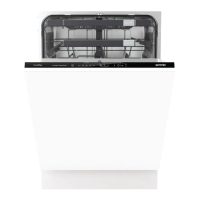Disposal
•
When the machine has reached the end of its service
life and is to be disposed of, it should immediately be
made unusable. Pull out the power cable and cut it as
short as possible.
•
The dishwasher is manufactured and labeled for recy-
cling.
•
Contact your municipality for information about where
and how your dishwasher can be recycled correctly.
Before washing for the first time
The water softener
In order to achieve good dishwashing results, the dishwash-
er needs soft water (water with low mineral content). Hard
water leaves a white coating on dishes and the dishwasher.
Water hardness is specified using the following scales: The
German water hardness scale (°dH) and the French water
hardness scale (°fH). A water supply with a water hardness
in excess of 6°dH (9°fH) must be softened. This is done
automatically with the aid of the built-in water softener. In
order for the softener to function optimally, it must be adjust-
ed to the hardness of the water supply.
Contact the local water utility to check the water hardness
in your area.
Adjusting the water softener
Chapter Settings on page 12 describes how to adjust the
water softener.
Fill up the salt
Before you begin using a dishwasher with a water softener,
you must fill the salt compartment with salt for the water
supply to be softened automatically. Use large grain salt or
special dishwasher salt.
WARNING!
In order to avoid rust stains, a dishwashing program must
be started immediately after adding salt.
Never pour dishwasher detergent into the salt compart-
ment. This destroys the water softener!
Do as follows the first time:
1
Unscrew the lid as illustrated.
2
Insert the funnel supplied with the dishwasher in the salt
compartment top-up hole. First, pour in about 0.3 gal (1
l) of water.
3
Then add salt, a maximum of 3 lb (1.5 kg), until the
compartment is full.
4
Wipe up any excess salt so that the lid can be screwed
on firmly.
5
Run a program to ensure that any salt in the dishwasher
is rinsed away.

